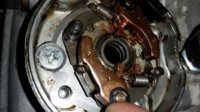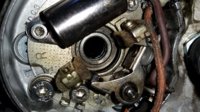I've been doing a ton of work to my bike and have found one problem that I just can't seem to get over.
I'd really like to have some feedback from people that may be able to help.
Here are my stats-
I've got a 1979 xs650 special. There are 10,000 original miles on it. It's running BS38 carbs and a 2 into 1 Delkevic exhaust header. I've sync'd the carbs and tuned the jetting to match my exhaust as best as possible. I've also replaced every seal and gasket in the carbs after thuroughly and meticulously cleaning them several times over.
My issue is that I have a runaway idle. Things were great with my cutoff stock head pipes. I had a small baffle in them and the bike ran well. Then I bought the new headers and put a light baffle in them. The new pipes though are much bigger and needed tuning. I ran through all the jets and found some good ones that matched the needed mix with the new free flowing exhaust. But I immediately found a runaway idle wich I atributed to a lean mix. So I kept moving up in jetting to richen it up, the problem was not being fixed though. I ended up replacing my throttle shaft seals and thought that may have been the final culprit as they were the last thing needing to be replaced, but no changes.
Eventually I put my stock cut off headers back on and it helped... But didn't fix the problem. It's not running away so often now, but it does run off once in a while when I'm blipping the throttle while in my workshop.
I'm figuring that by working up a new custom exhaust and properly creating the right restriction, I'll probably be able to get it to perform more like how it should. But I'm still worried about the innermitent runaway problem. I'd like to get rid of any chance of it doing that. I'm at a total loss though! What am I missing? What else would cause a runaway idle? I've checked the timing, the tappet clearances, carb jetting, and all the seals. Nothing seems to be wrong with any of it...! So what's causing the speedy idle?
Thoughts? Any help would be greatly appreciated!!! As soon as I can get it running right, I'm gonna tear it down for paint and then start enjoying it.
I'd really like to have some feedback from people that may be able to help.
Here are my stats-
I've got a 1979 xs650 special. There are 10,000 original miles on it. It's running BS38 carbs and a 2 into 1 Delkevic exhaust header. I've sync'd the carbs and tuned the jetting to match my exhaust as best as possible. I've also replaced every seal and gasket in the carbs after thuroughly and meticulously cleaning them several times over.
My issue is that I have a runaway idle. Things were great with my cutoff stock head pipes. I had a small baffle in them and the bike ran well. Then I bought the new headers and put a light baffle in them. The new pipes though are much bigger and needed tuning. I ran through all the jets and found some good ones that matched the needed mix with the new free flowing exhaust. But I immediately found a runaway idle wich I atributed to a lean mix. So I kept moving up in jetting to richen it up, the problem was not being fixed though. I ended up replacing my throttle shaft seals and thought that may have been the final culprit as they were the last thing needing to be replaced, but no changes.
Eventually I put my stock cut off headers back on and it helped... But didn't fix the problem. It's not running away so often now, but it does run off once in a while when I'm blipping the throttle while in my workshop.
I'm figuring that by working up a new custom exhaust and properly creating the right restriction, I'll probably be able to get it to perform more like how it should. But I'm still worried about the innermitent runaway problem. I'd like to get rid of any chance of it doing that. I'm at a total loss though! What am I missing? What else would cause a runaway idle? I've checked the timing, the tappet clearances, carb jetting, and all the seals. Nothing seems to be wrong with any of it...! So what's causing the speedy idle?
Thoughts? Any help would be greatly appreciated!!! As soon as I can get it running right, I'm gonna tear it down for paint and then start enjoying it.


